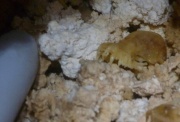Vertebrate (Inventory)/Bat Bones
From LagWiki
The Bat Bones field should be used to record any observances of bat remains.
Bat bones can be found primarily on the floor. Bat bones are very fine, fragile, and, except for the skull, needle-like. They can accumulate or be scattered. They may be on the surface or mixed into sediments and soils. They can be found clinging in popcorn or other rough surfaces but they will mostly be found on the floor and usually near a wall. Often the skulls may not be present or be much harder to locate. The skulls are small, about the size of a marble and very delicate. Sometimes, a complete bat skeleton is found intact and may be partially encased and preserved in calcite. Care should be taken not to disturb or step on any bat bones found.
Bat mummies are the dehydrated remains of bats with skin intact. There is no separate field on the form for bat mummies so they should be inventoried as bones. Bat mummies can be found on the floor or even still clinging to a wall or speleothem. Bat mummies are sometimes found covered with a growth which is usually a greenish color but could be several other colors making them hard to identify as bats. The color from this growth may remain long after the mummy is dehydrated.
Look carefully along the floor, on shelves or ledges and especially near walls for the fine bones. Seeing them may require a hands-and-knees examination. If rough speleothems are in the area such as popcorn, be sure to examine it for bones which may have been caught by it. And, if a significant guano deposit is found, it is likely to contain bones so examine it. If there is any indication that bats were once in the area, it is likely that bones are around, look for them.

